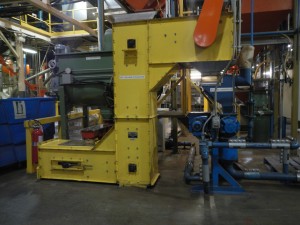Conveyor Systems Integration


Purchasing a bucket, aeromechanical, or flexible screw conveyor involves not only buying the right equipment and configuration, it also involves ensuring that the conveyor will successfully work as intended once it is installed into your processing line.

This requires an equipment supplier to fully understand the whole process and especially the equipment that is upstream and downstream. so that they can supply a unit designed and configured to ensure successful integration thus ensuring consistent process flow.
With a “Z” or “C” shaped bucket conveyor, particular attention has to be paid to the infeed. The infeed of product needs to be controlled or metered. Infeed chutes need to ensure good product flow and prevent overfilling the buckets or starving the process downstream. Under-filled buckets will not achieve the required throughput rate, while overfilling is likely to result in pillage and product loss, not to mention potential damage to the conveyor and production stoppage.
A good rule of thumb to follow is that the rate at which product is fed into the infeed chute should be no more than 75% of the capacity of the conveyor.

To promote good material flow into the infeed of a bucket conveyor, careful attention should be paid to the design of the conveyor infeed chute. The cross-section and wall angle of the chute should be such that material does not get hung up in the chute or accumulate unnecessarily. A good application review, including material test, will allow the equipment supplier to determine the optimal chute design parameters for any given process.
At the infeed end, it may be difficult to achieve a consistent flow rate into the conveyor when handling materials that may stick, cake, or pack in the infeed chute. To alleviate this problem, good equipment designers will recommend the installation of flow aids, such as a vibratory feeder, to achieve a reliable connection with upstream feeding equipment.

At the discharge end, good conveyor systems integration addresses the issues of securing the complete discharge of material from the conveyor. Incomplete discharge erodes process throughput and can result in downstream equipment being starved of material. Installing flow aids, such as a bucket knocker, at the conveyor discharge may be required to achieve complete emptying of material from the conveyor buckets.
Another critical aspect of system integration is synchronizing the operating rate of a conveyor with that of upstream or downstream equipment. Outfitting the conveyor with a variable frequency drive (VFD) will help fine tune the operating speed of the conveyor, making it easier to synchronize the conveyor with equipment both upstream and downstream.
At UniTrak, we understand the issues and challenges of successful conveyor systems integration. We never just “supply” equipment. In every project, we go beyond equipment supply to ensure that every conveyor that we build will successfully integrate in the customer’s process and system. To achieve this, we draw upon our 45-plus years experience in achieving successful conveyor system integration, while our equipment “customerization” process ensures that all integration issues are identified and addressed.
If you have a conveyor integration issue or challenge you would like to solve, or would like to know more about our equipment, please contact our sales department today.

© UniTrak 2022. All rights reserved.